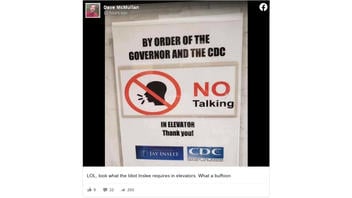
Did Washington state Gov. Jay Inslee order that no one speak in elevators to help slow the spread of coronavirus? No, not quite: His office released guidance that strongly advises no talking in elevators.
The claim appeared in a Facebook post (archived here) where it was published on December 7, 2020, with the caption "LOL, look what the Idiot Inslee requires in elevators. What a buffoon." The image read:
BY ORDER OF THE GOVERNOR AND THE CDC
NO Talking IN ELEVATOR Thank you!
This is what the post looked like on Facebook at the time of writing:
(Source: Facebook screenshot taken on Tue Dec 8 16:12:28 2020 UTC)
The November 16, 2020, guidance from Gov. Inslee's office included the following requirement:
Adhere to CDC elevator and escalator protocols. Also, post signs strongly advising no talking in elevators.
While building owners might have posted a "NO Talking" sign in elevators, the governor's order does not go that far, nor does it dictate the wording of elevator signs.
When Lead Stories reached out to Inslee's office about the sign in the Facebook post, Mike Faulk, the governor's deputy communications director said, "I've never heard the governor say that."
The CDC guidance Inslee's order refers to is the following:
- Encourage occupants to take stairs when possible, especially when elevator lobbies are crowded or when only going a few flights.
- Where feasible, designate certain stairwells or sides of stairwells as "up" and "down" to better promote social distancing.
- Use floor markings in elevator lobbies and near the entrance to escalators to reinforce social distancing. Place decals inside the elevator to identify where passengers should stand, if needed.
- Use stanchions (for lobbies only; not inside elevators) or other ways to mark pathways to help people travel in one direction and stay 6 feet apart.
- Encourage the use of cloth face coverings by all elevator and escalator occupants. Ask elevator occupants to avoid speaking, when possible.
- Consider limiting the number of people in an elevator and leaving steps empty between passengers on escalators, where possible, to maintain social distancing.
- Post signs reminding occupants to minimize surface touching. They should use an object (such as a pen cap) or their knuckle to push elevator buttons.
- Encourage elevator and escalator passengers to wash their hands and avoid touching their face after holding on to handrails or touching buttons.
- Consider adding supplemental air ventilation or local air treatment devices in frequently used elevator cars.















